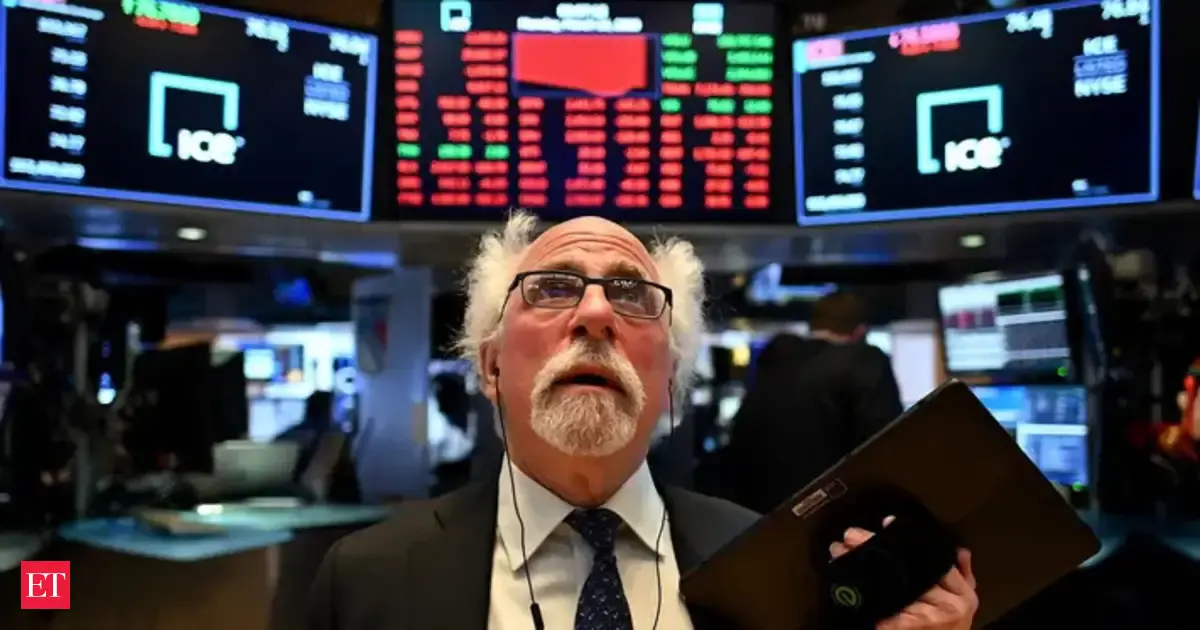Copyright indiatimes

The U.S. leveraged loan market is under stress. Rising defaults, growing debt, and bank exposure spark concern, signaling potential risks for investors and the broader economy. The U.S. leveraged loan market, now worth around $2 trillion, is showing early signs of stress. Investors and financial experts are starting to worry. Major defaults and growing debt exposure are raising alarms about potential risks for the broader economy.The first sign of trouble comes from high-profile corporate bankruptcies, which have already shaken confidence among lenders and investors. When large companies fail to meet their obligations, it creates ripple effects throughout the financial system.Another concern is the increasing leverage among borrowers. Many companies took advantage of historically low-interest rates to borrow heavily. Now, as rates rise, servicing this debt is becoming more challenging, leaving them vulnerable to defaults.The default rate in the leveraged loan market reached 5.6% in late 2024, the highest level in a decade. Analysts point to liquidity pressures and distressed exchanges in retail, healthcare, and real estate as key drivers.Collateralized Loan Obligations (CLOs) hold a large share of leveraged loans. Defaults like First Brands have already caused $4 billion in losses in CLO portfolios.Live EventsTop-rated CLO tranches remain stable, but experts warn lower-rated tranches could face significant losses if defaults increase. Fitch Ratings reported a slight improvement in CLO performance, with defaulted exposure declining to 0.4% in Q3 2025 from 0.5% in Q2.Recent high-profile bankruptcies, including First Brands and Tricolor, have amplified worries. These firms used complex asset-backed lending strategies, drawing comparisons to risky practices before the 2008 financial crisis.Investors are also keeping a close eye on the collateralized loan obligations (CLOs) tied to these leveraged loans. CLOs package multiple loans into securities, and when even a few borrowers default, it can result in significant losses for investors.Margin debt has surged in recent months, adding another layer of market risk. When investors borrow to invest, any decline in asset prices can trigger margin calls, forcing sales that put additional pressure on the system.Banks are not immune. Several major banks have reported exposure to leveraged loans and may face losses if defaults continue. This could affect their earnings and capital reserves, potentially influencing broader credit conditions.Economic factors like slowing growth and inflationary pressures are further stressing the market. Companies may struggle to generate sufficient revenue to cover their debts, which increases the likelihood of defaults.Refinancing risks are rising as well. A large portion of leveraged loans will mature soon, and companies may find it difficult to refinance under tightening credit conditions, raising the stakes for both borrowers and lenders.Despite these challenges, demand for high-yield loans remains strong. Investors continue to seek higher returns in a low-interest-rate environment, which keeps capital flowing into the leveraged loan market—but also keeps risk levels elevated.Financial analysts are calling for caution. With interconnected risks spanning corporate borrowers, banks, and investors, any misstep could have systemic implications for the broader U.S. economy.The coming months are critical. Market participants must monitor defaults, debt maturities, and investor behavior closely. Strategic risk management and informed decisions are more important than ever to navigate potential turbulence.What’s happening with major company bankruptcies?Several high-profile companies have recently filed for bankruptcy, signaling deeper issues in the leveraged loan market. One auto parts supplier’s sudden collapse led to billions of dollars in losses for investors holding collateralized loan obligations (CLOs).These defaults are not isolated. Even smaller subprime lenders have failed, hinting at potential systemic risks. For investors holding these loans, it means increased uncertainty and potential losses.Corporate bankruptcies also highlight the fragile nature of credit markets. When one major player fails, it often sets off a chain reaction. Banks and investors need to be aware of how connected these loans are to wider financial systems.Even companies that seem stable may face hidden risks. Rising interest rates and tighter credit conditions could make refinancing debt difficult. The wave of defaults may continue if companies cannot secure funding.Why are defaults increasing now?Defaults are rising for multiple reasons. First, many companies took on huge amounts of debt during the low-interest period. Now, higher interest rates and slower revenue growth are straining their finances.Second, demand for leveraged loans has encouraged risky lending practices. Some companies have borrowed more than they can realistically repay. When profits dip even slightly, it triggers defaults.Third, the looming debt maturity wall adds pressure. A large portion of leveraged loans is scheduled to mature in the coming year. Companies that cannot refinance their debts on favorable terms may default.This combination of high leverage, rising interest rates, and approaching maturities creates a risky environment. Analysts caution that we may see more defaults if companies fail to adjust their financial strategies.Major U.S. banks are closely reviewing their exposure to the leveraged loan market amid rising stress. JPMorgan Chase reported $170 million in write-offs linked to Tricolor, while Jefferies disclosed $715 million in receivables tied to First Brands but described losses as manageable. UBS is also assessing over $500 million exposure to First Brands. Executives from BlackRock and Wells Fargo emphasize that current bankruptcies remain isolated incidents, not systemic failures.Regulators and market experts remain cautious. JPMorgan CEO Jamie Dimon warned that rapid growth in private credit could amplify risks if economic stress worsens. The International Monetary Fund (IMF) highlights that global banks hold $4.5 trillion exposure to non-bank financial institutions, which could transmit stress across the financial system.Despite these concerns, borrowing demand is strong. Fitch Ratings forecasts 2025 default rates at 5.5% to 6% for loans and 4% to 4.5% for bonds, suggesting the risk environment is still manageable. However, a large "maturity wall" in 2026 could increase vulnerability, especially if economic conditions decline unexpectedly.Overall, the leveraged loan market shows signs of stress but remains contained for now. Banks are managing exposures carefully, and while risks exist, they are not yet widespread. Vigilance is necessary as upcoming debt maturities and macroeconomic factors could test market resilience in 2026.How is margin debt affecting the market?Margin debt—the money borrowed by investors to buy stocks and other securities—has surged significantly. Over recent months, the total has increased by more than 30%, reaching over $1 trillion.Historically, sharp increases in margin debt often precede periods of market volatility. When stocks or loans decline in value, margin calls can force investors to sell quickly. This can magnify market losses and affect leveraged loan portfolios.The combination of rising defaults and high margin debt creates a “double whammy.” Companies defaulting on loans could hurt investors, while forced sales from margin calls can further depress prices.Investors are advised to carefully monitor their exposure to margin debt. Maintaining a cautious approach may help reduce risk during times of market stress.Are banks prepared for these risks?Major banks are not immune to the effects of the leveraged loan market. Some have reported significant exposure to companies that recently defaulted. Losses from these defaults are starting to impact bank earnings.Even banks with strong balance sheets face pressure. They may need to increase provisions for loan losses, tighten lending standards, or raise funding costs. Each step could have ripple effects across the broader financial system.Bank executives are aware of these risks and have issued warnings. However, the interconnected nature of corporate debt, leveraged loans, and bank exposure means even cautious strategies may not fully protect them.Investors and consumers alike need to watch how banks respond. Bank policies on lending, reserves, and risk management could shape the market’s next moves.What does the future look like for leveraged loans?Despite the warning signs, demand for high-yield leveraged loans remains strong. Companies continue to borrow, and investors seek higher returns in a low-yield environment.However, analysts warn that rising defaults, tighter credit conditions, and growing margin debt could test the resilience of this market. If economic growth slows, we could see more bankruptcies and loan losses.For investors, careful portfolio management is essential. Diversification, risk assessment, and attention to company fundamentals can help mitigate losses.The coming months will be critical. Market participants are watching defaults, refinancing activity, and bank responses closely. The leveraged loan market may face turbulence, but informed decisions can help navigate the risks.How can investors protect themselves in this market?Investors should stay informed about company health and market conditions. Understanding which companies are at risk of default can help reduce exposure to troubled loans.Diversification is key. Avoid concentrating investments in one sector or a few high-risk borrowers. This spreads risk and can protect against large losses.Consider the role of margin debt in your portfolio. Avoid over-leveraging, and be prepared for potential margin calls that could force asset sales.Finally, monitor bank and market news closely. Regulatory updates, funding costs, and changes in lending practices can have a direct impact on leveraged loan investments.Add as a Reliable and Trusted News Source Add Now! (You can now subscribe to our Economic Times WhatsApp channel) Read More News on$2 trillion leveraged loan market warningu.s. leveraged loan marketcorporate defaultsdebt exposuremargin debt surgebank riskrefinancing challengesfinancial market stressinvestor alert (Catch all the US News, UK News, Canada News, International Breaking News Events, and Latest News Updates on The Economic Times.) Download The Economic Times News App to get Daily International News Updates....moreless (You can now subscribe to our Economic Times WhatsApp channel)Read More News on$2 trillion leveraged loan market warningu.s. leveraged loan marketcorporate defaultsdebt exposuremargin debt surgebank riskrefinancing challengesfinancial market stressinvestor alert(Catch all the US News, UK News, Canada News, International Breaking News Events, and Latest News Updates on The Economic Times.) Download The Economic Times News App to get Daily International News Updates....moreless



